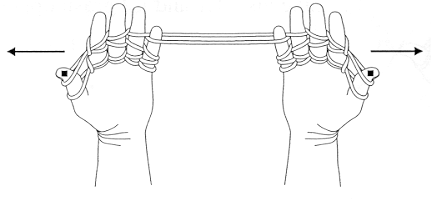Dr. Storer classifies tricks into six categories: knots, plaits, do-as-I-do tricks, swindles, releases, and illusions. The four string tricks described in this issue of String Figure Magazine are popular releases.
To enhance the reader's enjoyment, a continuation move has been added to the first three examples so that the string can be woven a second, third, or fourth time before the release is performed.
In Storer's monograph on string tricks, this release is classified as trick V.C.2, variation 2. One handed versions are known worldwide, and are often called 'Cutting the Fingers'.
In the early 1900s Diamond Jenness collected this two-handed version from the Inuit. Although they had no name for it, it was known everywhere from Point Barrow, Alaska, to the Coronation Gulf in the Canadian Arctic.

This release trick, invented by Joseph D'Antoni, was originally featured in the September 1998 issue of String Figure Magazine. Here, the author provides readers with a continuation move that allows us to add another layer of complexity to the trick.

This release, dubbed 'A German Trick' by Kathleen Haddon (because her sister learned it in Berlin!), is widely distributed. In Storer's monograph, it is classified as trick V.C.3, variation 1. According to Elffers & Schuyt, it first appeared in a Dutch physics book published in 1869, where it was inexplicably called 'The Smith's Secret'. In addition to being known throughout Europe, it is also known in the Americas, the Pacific, the Arctic, and in Asia.
The continuation move devised by Joseph D'Antoni is essentially the same as that used in the previous trick.

The popularity of this widely distributed slip trick soared after Touchstone Pictures released The Horse Whisperer, based on a novel by Nicholas Evans. In it, actor Robert Redford plays a rancher who is able to communicate with horses thanks to keen intuition. Actress Kristin Scott Thomas plays an urban professional who seeks his advice after her daughter survives a devastating riding accident. The string trick, performed by Redford after a leisurely evening meal, appears in a pivotal scene in which Thomas is learning to appreciate the "simple pleasures" of country life. Ultimately, the trick becomes a symbol of Redford himself, who "slips away" after Thomas falls in love with him.
Although most movie fans do not realize it, this trick appeared in Jayne's book as 'A Finger Catch'. She learned it at the St. Louis Exposition from a Chippewa Indian Chief, way back in 1904. According to Kathleen Haddon, it is also known among the Navajo Indians. In Storer's monograph, it is classified as trick V.B.8.
Since Jayne's original description includes only three drawings, we decided to re-illustrate it here and describe the hand movements in greater detail.
